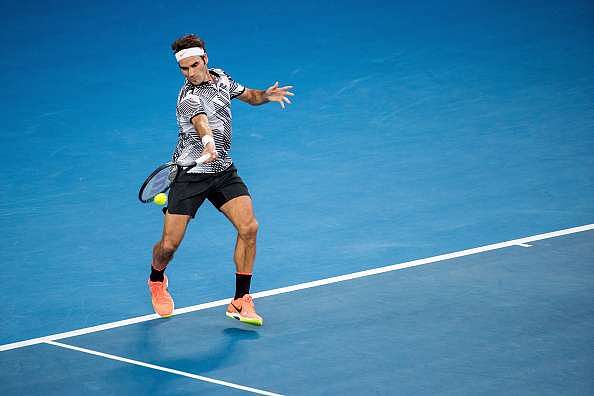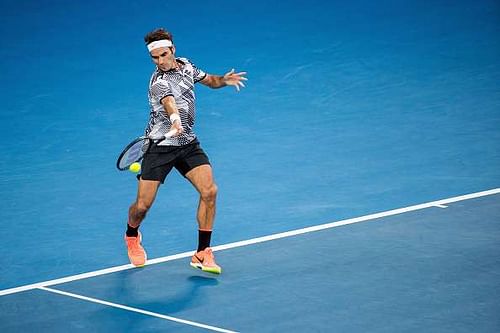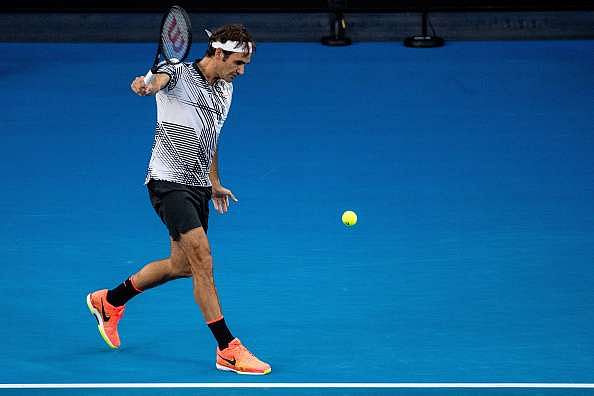
Did Federer really 'out-Rafa' Nadal in the 2017 Australian Open final?

Roger Federer's forehand was as fearsome as ever in the final of the 2017 Australian Open
Years from now, when we look back at the 2017 Australian Open final, we will probably rub our eyes in disblief and ask ourselves, “Did that really happen?”
You may think I'm exaggerating, but practically everything about the last match of 2017's first Grand Slam was unlikely. There were the protagonists themselves, veterans in their 30s who were rebounding from extended layoffs and whose Slam-winning prospects had been all but written off. There was the fact that both Novak Djokovic and Andy Murray – two players who had distanced themselves from the rest of the tour over the previous couple of years – were absent. And then, finally, there was the result.
When Rafael Nadal confirmed the ‘dream final’ by defeating Grigor Dimitrov in five pulsating sets, the winner of the title was already decided in most people's minds. The prevailing belief was that Federer had less than 30% chance of winning, and the only way he could do that was by blowing the Spaniard off the court in four sets or less.
If it went to five sets? Federer was toast.
Yes, Nadal did have a considerably more taxing semifinal, and he also had one less day of rest. But those same things were true in 2009 too, and we all know how that final turned out.
Nadal may not be 22 anymore, but he's still fitter than 99% of the tour. More importantly, he has shown in the past that no matter what the situation or court, he owns Federer in a way that few other champions in any sport have been owned. 2008, 2009, 2012, 2014 – the number of times Nadal has come along to spoil Federer's party against all odds, has been nothing short of sensational.
And yet, not only did Federer end up defeating Nadal yesterday in five thrilling sets, he did it after going a break down in the decider. And after squandering as many as nine break points towards the home stretch.
That, to put it plainly, is just not supposed to happen.
Nadal had Federer right where he wanted him, and he was armed with the full psychological force of his 23-11 head-to-head record – which included many wins that had seemingly broken the Swiss’ spirit for good. Who would've bet against Nadal when he held for 3-1 in the fifth set, just three games away from yet another deeply scarring defeat for Federer?
The short answer: no one. As most had predicted before the match, the moment it went five sets, Federer was expected to be toast. Which is why the next five games, all of which were won by Federer, will go down as one of the most imporable periods of play ever seen in tennis – on par with those fourth set tie-breakers between Nadal and Robin Soderling at the 2009 French Open, and between Federer and Sergiy Stakhovsky at the 2013 Wimbledon.
How did the ‘toast’ turn things around though? Did he really ‘out-Rafa’ Rafa, as John McEnroe put it so glibly? How did he do it?
Federer struck 73 winners in the match against 57 errors, both of which are high numbers. Take away the serve (20 aces and three double faults), and we are left with a groundstrokes ratio of 53 winners to 54 unforced errors. That should tell us that this wasn't the cleanest Federer match of all time. Heck, it wasn't even his cleanest match in this tournament; he had a far better ratio against both Tomas Berdych (32 winners to 15 errors) and Kei Nishikori (59 to 41).
One major difference in Federer's play yesterday was the way he hit his backhand. Driving it flat and hard crosscourt, he used the tried-and-tested formula of taking time away from Nadal's forehand side to gain the ascendancy in the rallies. The slice was used only when he had no other option, and the down-the-line bullet was unleashed just often enough to keep the Spaniard on his toes.

Roger Federer's backhand was on fire almost throughout the match; who expected that?
So what if Federer doesn't have a two-handed backhand a la Djokovic and Nishikori? On the relatively faster Melbourne courts this year, even his dainty little one-hander was good enough to do the damage. He took the ball supremely early and finished with 14 groundstroke winners off his backhand side in the final, which was probably 14 more than anyone expected.
The most astounding stat of the day? Federer hit eight backhand winners in the last set, which was more than the seven he struck off the forehand. To think that your greatest liability would turn into your biggest strength when the stakes were the highest – absolutely unbelievable.
More than the numbers though, it was Federer's conviction to stick to his guns that stood out. His forehand was as aggressive as ever; he didn't look as wary about blasting the inside-out version as he usually does against Nadal. That, together with his newfound confidence on his backhand, ensured that he had the upper hand in court positioning almost throughout the match – even when he was gasping for air in the fourth and fifth sets.
Federer's net play was unexpected too – because of how little he used it. Considering the faster court and Nadal's legendary baseline prowess, it seemed almost a given that Federer would have to frequently go to the volleying well if he hoped to subdue the Spaniard. But the Swiss came to the net ‘only’ 40 times, winning 29 of those points; to everyone's surprise, he did the bulk of his heavy lifting from the baseline.
If Ivan Ljubicic wanted to show the world once and for all that it was him, and not Stefan Edberg, who was coaching Federer now, the 2017 Australian Open final would be the perfect demonstration. Like Ljubicic the player and unlike Edberg the player, Federer was all about the baseline play against Nadal.
The Swiss also refused to retreat behind the baseline at any point in the match, which was a telling change. In the past, he has often been forced to give up ground against Nadal, with the Spaniard's heavy topspin pushing him way off the court. Against a player like Nadal, it is always tempting to go to extremes – either stand well behind the baseline and neutralize the spin, or go haring up the forecourt to smother the spin before it touches the ground. Needless to say, Nadal usually makes both of those plays backfire spectacularly.
So Federer chose the next available option; do what you always do, just try and execute it better because you're playing against an all-time great. He hugged the baseline like he's never hugged anything in his life, and used his superhuman reflexes to redirect the ball to all the corners of the court. It was a high-risk play, but since this was destined to be Federer's day, it ended up paying him huge rewards.
No point was more emblematic of that than the epic 26-shot rally that the two rivals staged deep into the fifth set, which ended with Federer caressing a half-volley forehand winner down the line to bring up yet another break point. The point could well be held up as the model represenation of power baseline tennis, except that as it stretched on, Federer crept further and further up inside the court - and he ended it with a shot that would have made grasscourt mavens of the past proud.
Before the final, Federer was a little cagey about his strategy against Nadal, which seemed to suggest he had a new tactic or two up his sleeve. When asked to elaborate on his earlier statement that he had played too many claycourt matches against Nadal in the early days of their rivalry which had impacted the way he played against the Spaniard, Federer snapped, “Why give him an edge? I said enough.”
He then went on to talk about the unique situation he and Nadal were now in. “Now it's a different time. A lot of time has gone by. I know this court allows me to play a certain game against Rafa that I cannot do on Centre Court at the French Open.”
But if his play in the final is anything to go by, Federer actually seemed to have approached the match like he would against any other player. He didn't shy away from coming over his backhand, he didn't insist on making kamikaze net approaches, and he didn't look to attack Nadal's backhand as much as he had in the past.
That was pretty much confirmed from his comments in the post-match press conference.
“I told myself to play free...You play the ball, you don't play the opponent. Be free in your head, be free in your shots, go for it. The brave will be rewarded here.”
But for all of that positive thinking by Federer, the dynamics of his match-up against Nadal are almost too unfavourable to overcome. Fortunately for him, he had help.
Yesterday, Nadal wasn't at his erratic worst from 2016, but he wasn't at his best either. Both the break points he lost in the fifth set – and he saved the other nine with some trademark back-to-the-wall intensity – ended with forehand errors. Moreover, all through the match he seemed unwilling to chase down as many balls as he usually does, which allowed Federer to occasionally get away with not approaching the net.
Did the gruelling semifinal against Grigor Dimitrov take too much out of Nadal? We didn't think it would, but maybe there IS a difference between the age of 22 and 30 after all.
No matter what had transpired until that moment though, the last game of the match was all Federer. After going down two break points, with visions of his previous heartbreakers swimming ominously around his head, he slammed down an ace and followed that up with a scorching inside-out forehand winner.
While the Swiss may have channelled his inner Nadal to come back from 1-3 down in the decider, those two break points he saved were – there's no other way to put it – vintage Federer.
A lot of people have been tempted to call this the best Fedal clash of all time, probably because of the insane amount of emotion it involved and the fact that contrary to expectations, it actually went to five sets. But let's not get carried away; neither Federer nor Nadal was at his absolute best yesterday. This wasn't the Federer of the 2015 Wimbledon semifinal, where everything he touched turned to gold. And this certainly wasn't the Nadal of the 2009 Australian Open, where absolutely no shot seemed capable of going past him.
But this was still a memorable affair, because of how unlikely everything about it was. The result, the approach of the two players, the challenge on match point; even the medical timeout scenario was different – this time it was Federer who called for it.
Did Federer ‘out-Rafa’ Nadal though? Only if making a fifth-set comeback is the sole preserve of the Spaniard. Federer may have stolen the match from his nemesis when all seemed lost, but in many other respects this was a quintessentially Swiss performance.
He regularly oscillated between the brilliant and the ordinary in his play, and the wasting of final-set break points has heralded many a classic Federer loss in the past. That he still came out the victor yesterday was partly down to good fortune, but mainly down to his newfound conviction in sticking to his attacking approach.
Six months on the sidelines can make a player unsure of his game; at the age of 35, the doubts are sure to be compounded even further. But we should've learned by now that the normal rules don't apply to people like Roger Federer.
The Swiss used the time off to sharpen his focus, and to realize that if he trusted his game enough, it was still good enough to win Slams.
Even against Rafael Nadal.